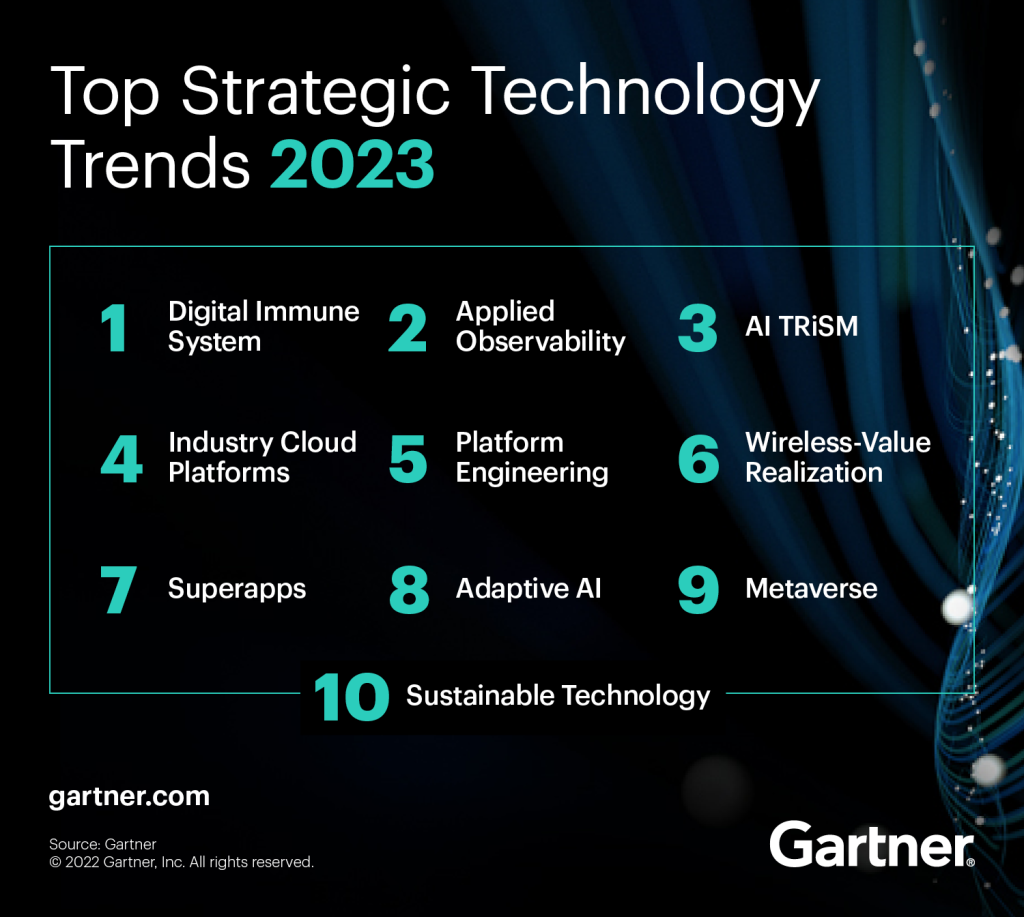Uncover The Game-Changing New Technology Trends For Business And Supercharge Your Success
New Technology Trends for Business
Introduction
Dear Readers,
Welcome to our article on the latest technology trends for business. In today’s rapidly evolving digital landscape, staying up-to-date with the latest advancements is crucial for any business looking to thrive. In this article, we will explore the most significant trends that are reshaping the way businesses operate and provide you with valuable insights to help you stay ahead of the competition.
2 Picture Gallery: Uncover The Game-Changing New Technology Trends For Business And Supercharge Your Success


Nowadays, technology is a fundamental driver of innovation and growth. As new technologies emerge, they have a profound impact on various industries, revolutionizing the way businesses conduct their operations, interact with customers, and create value. Understanding and harnessing these trends can give your business a competitive edge and open up new opportunities for growth.
In this article, we will cover the following:
1. The What

Image Source: devtechnosys.com
💡 Exploring the latest technology trends and their significance for businesses.
2. The Who
💡 Identifying the key players and industries that are embracing these new technologies.
3. The When
💡 Understanding the timeline of adoption for these technologies and their future potential.
4. The Where

Image Source: gcom.cloud
💡 Examining the geographical impact of these trends and the regions leading the way.
5. The Why
💡 Unraveling the motivations behind businesses’ adoption of these technologies.
6. The How
💡 Providing practical insights on how businesses can successfully implement these technologies.
7. The Advantages and Disadvantages
💡 Analyzing the pros and cons of each technology trend and the potential risks involved.
8. FAQ
💡 Answering the most frequently asked questions about these technology trends.
9. Conclusion
💡 Encouraging readers to take action and embrace these technology trends in their businesses.
10. Final Remarks
💡 Providing additional insights and a disclaimer regarding the information presented.
1. The What
The technology landscape is constantly evolving, and it is crucial for businesses to stay informed about the latest trends. Below, we explore some of the most significant technology trends that are reshaping the business world:
Artificial Intelligence (AI) and Machine Learning
AI and machine learning have taken center stage in recent years, revolutionizing various industries. These technologies enable computers to learn, analyze, and make predictions without explicit programming, leading to increased efficiency, accuracy, and automation.
Internet of Things (IoT)
The IoT refers to the network of interconnected devices, vehicles, and appliances that can communicate and exchange data. In a business context, IoT can enhance operational efficiency, enable real-time monitoring, and improve decision-making processes.
Blockchain
Blockchain technology provides a decentralized and secure way to record and verify transactions. It has the potential to revolutionize industries such as finance, supply chain management, and healthcare by increasing transparency, reducing fraud, and improving trust.
Cybersecurity
With the increasing reliance on technology, cybersecurity has become a critical concern for businesses. Protecting sensitive data, systems, and networks from cyber threats is essential to maintain trust and safeguard business operations.
Cloud Computing
Cloud computing allows businesses to access and store data and applications over the internet, eliminating the need for on-premises infrastructure. It offers scalability, cost-efficiency, and flexibility, enabling businesses to focus on their core competencies.
Big Data Analytics
The ability to analyze and extract valuable insights from large volumes of data has become a game-changer for businesses. Big data analytics provides actionable intelligence, enabling businesses to make data-driven decisions, improve customer experiences, and drive innovation.
Augmented Reality (AR) and Virtual Reality (VR)
AR and VR technologies provide immersive experiences that blend the physical and digital worlds. They have immense potential across industries such as gaming, retail, healthcare, and education, enabling businesses to enhance customer engagement and create innovative solutions.
2. The Who
Various industries are embracing these new technology trends to drive innovation and gain a competitive advantage. Some of the key players leading the way include:
1. Finance and Banking
The finance and banking sector is leveraging technology to enhance security, streamline processes, and deliver personalized customer experiences. AI-powered chatbots, blockchain-based transactions, and mobile banking apps are just a few examples of how technology is transforming this industry.
2. Healthcare
In the healthcare sector, technology is revolutionizing patient care, diagnosis, and treatment. Electronic health records, telemedicine, AI-enabled diagnostics, and wearable devices are transforming the way healthcare providers deliver services and improve patient outcomes.
3. Retail and E-commerce
Technology has disrupted the retail industry, enabling businesses to offer personalized shopping experiences, optimize supply chain management, and reach customers through various channels. E-commerce platforms, mobile payment solutions, and AI-driven recommendations are driving this transformation.
4. Manufacturing
Manufacturing companies are embracing technology to automate processes, improve operational efficiency, and enable smart factories. Robotics, AI-powered quality control systems, and predictive maintenance tools are revolutionizing the manufacturing landscape.
5. Transportation and Logistics
The transportation and logistics industry is leveraging technology to optimize route planning, track shipments in real-time, and enhance customer experiences. IoT-enabled sensors, autonomous vehicles, and AI-powered logistics platforms are driving innovation in this sector.
3. The When
The adoption of these technology trends varies across industries and regions. While some businesses have already embraced these technologies, others are still in the early stages of exploration. The timeline for adoption depends on various factors, including the complexity of implementation, regulatory considerations, and industry-specific challenges.
However, the pace of technology adoption is accelerating, and businesses that fail to adapt may risk falling behind their competitors. It is crucial to stay informed and evaluate the potential benefits and risks of each technology trend to make informed decisions about when to implement them.
4. The Where
Technology trends are not limited by geographical boundaries. However, certain regions have emerged as leaders in adopting and implementing these technologies:
1. Silicon Valley and the United States
Silicon Valley in California, USA, is renowned as a global hub for technological innovation. Many tech giants and startups are based in this region, making it a hotspot for cutting-edge technology trends.
2. China
China has witnessed rapid technological advancements in recent years, driven by its large population, strong government support, and thriving tech ecosystem. Chinese companies are at the forefront of AI, e-commerce, and mobile payments.
3. Europe
European countries, such as Germany, the United Kingdom, and Sweden, are known for their technological expertise. These countries have invested heavily in research and development, leading to advancements in various industries.
4. India
India is a rising force in the technology landscape, with a growing number of startups and a vast pool of skilled IT professionals. The country has made significant strides in AI, fintech, and e-commerce.
5. The Why
Businesses have compelling reasons to embrace these technology trends:
1. Stay Competitive
Adopting the latest technologies enables businesses to stay ahead of the competition and meet evolving customer expectations. Failure to embrace these trends may result in losing market share to more tech-savvy competitors.
2. Increase Efficiency and Productivity
Technology trends such as AI, IoT, and automation can significantly improve operational efficiency, streamline processes, and reduce costs. By leveraging these technologies, businesses can achieve higher productivity and allocate resources more effectively.
3. Enhance Customer Experiences
Technology enables businesses to deliver personalized and seamless customer experiences. From AI-powered chatbots to data-driven recommendations, businesses can leverage technology to understand customer preferences and tailor their offerings accordingly.
4. Drive Innovation
Embracing technology trends fosters a culture of innovation within organizations. By leveraging the latest advancements, businesses can develop new products, services, and business models that disrupt the market and create new revenue streams.
6. The How
Implementing technology trends in your business requires careful planning and execution. Here are some practical insights to help you navigate the process:
1. Assess Your Business Needs
Start by identifying the pain points and areas where technology can add value to your business. Conduct a thorough assessment of your current processes, customer needs, and industry trends to determine the most suitable technologies for your organization.
2. Research and Stay Informed
Stay updated with the latest advancements in technology by following industry publications, attending conferences, and networking with experts. Continuous learning is essential to make informed decisions and stay ahead of the curve.
3. Collaborate with Experts
Seek partnerships or collaborations with technology experts, consultants, or solution providers. Their expertise can help you navigate the complexities of implementation and ensure a smooth transition to new technologies.
4. Develop a Roadmap
Create a detailed roadmap that outlines the steps, resources, and timelines required to implement the chosen technology trends. Break down the implementation into manageable phases and prioritize high-impact areas.
5. Train Your Workforce
Invest in training and upskilling your employees to adapt to the new technologies. Provide them with the necessary tools, knowledge, and support to embrace and leverage these advancements effectively.
6. Monitor and Adapt
Regularly monitor your technology implementation and measure its impact on your business. Be prepared to adapt and make adjustments as needed, as technology trends continue to evolve rapidly.
7. The Advantages and Disadvantages
Advantages:
1. Increased efficiency and productivity through automation and AI-powered systems.
2. Enhanced decision-making capabilities through big data analytics and real-time insights.
3. Improved customer experiences through personalized interactions and seamless processes.
4. Cost savings through cloud computing, eliminating the need for extensive infrastructure.
5. Streamlined operations and supply chain management through IoT-enabled systems.
Disadvantages:
1. Potential cybersecurity risks and data breaches.
2. Implementation challenges and costs associated with adopting new technologies.
3. Resistance to change within the organization and employee training requirements.
4. Privacy concerns related to the collection and use of customer data.
5. The possibility of job displacement due to automation and AI.
8. Frequently Asked Questions (FAQ)
1. What are the key technology trends shaping the business world?
Some key technology trends shaping the business world include artificial intelligence, blockchain, Internet of Things, cloud computing, and big data analytics.
2. How can businesses benefit from adopting these technology trends?
Businesses can benefit from adopting these technology trends by staying competitive, increasing efficiency, enhancing customer experiences, and driving innovation.
3. Are there any risks associated with implementing these technologies?
Yes, implementing these technologies can involve cybersecurity risks, implementation challenges, and potential job displacement. It is essential to assess these risks and mitigate them effectively.
4. Which industries are at the forefront of adopting these technology trends?
Industries such as finance and banking, healthcare, retail and e-commerce, manufacturing, and transportation and logistics are at the forefront of adopting these technology trends.
5. How can businesses successfully implement these technology trends?
Successful implementation requires careful planning, research, collaboration with experts, development of a roadmap, employee training, and continuous monitoring and adaptation.
9. Conclusion
Dear Readers,
As technology continues to advance at a rapid pace, it is crucial for businesses to embrace the latest trends to stay competitive and drive growth. By understanding the what, who, when, where, why, and how of these technology trends, you can position your business for success in the digital age.
From AI and IoT to blockchain and big data analytics, the possibilities are endless. It is up to you to seize these opportunities, assess the risks, and navigate the complexities of implementation. By doing so, you can unlock new levels of efficiency, productivity, customer satisfaction, and innovation.
Remember, technology is not just a tool; it is a catalyst for transformation. Embrace it, harness its power, and lead your business into a future where possibilities are limitless.
10. Final Remarks
Dear Readers,
We have endeavored to provide you with valuable insights into the new technology trends shaping the business world. However, it is important to note that technology is constantly evolving, and new trends may emerge in the future.
The information presented in this article is intended to serve as a guide and starting point for your
This post topic: Latest Technology Trends

